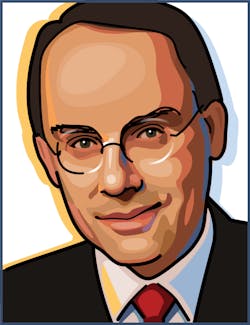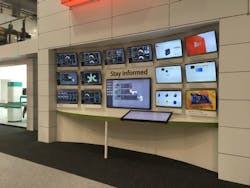Four laser companies to exceed $1 billion revenue in 2016

The year is closing and it looks like a good one for most players in laser industry. But for some it was very special—probably four of them will cross the line of $1 billion in revenue, mostly for the first time. These four companies represent a substantial part of the $12 billion market for lasers and laser systems. Still, it is a healthy and competitive market and it is growing faster than most of stocks.
And this market is changing. I first had an inkling of this at the Stuttgart Laser Technology Forum in June 2014, when I heard Peter Leibinger, Vice Chairman of Trumpf, saying that the laser is becoming a commodity. And he also referred to a Chinese trade show where he counted almost 100 providers of laser cutting machines.
Now the interesting question is: How do the big makers of lasers and laser systems react to the changes in the market? What ideas for growth do they disclose? In fact I found some insights about these companies, and they differ remarkably.
Just married: Coherent Inc.
It came as a surprise when Coherent (NASD: COHR; Santa Clara, CA) announced the acquisition of Rofin Sinar in March 2016. And probably all involved parties had a sigh of relief when the European Commission approved it in October, subject to the sale of Rofin’s low power CO2 business in Hull (UK). The total annual revenue of Coherent ($857m for FY2016) and Rofin Sinar ($520m in FY 2015) adds up to more than $1.3 billion if we take the last separately counted numbers.
John Ambroseo, the president and CEO of Coherent explained the market position of the merged company in a conference call in November: “Coherent participates in four end markets: microelectronics, instrumentation, scientific, and materials processing. On a stand-alone basis, we have leading market positions in the first three and a trailing position in materials processing.”
In FY 2015 Coherent sold about 50% ($406m) into the microelectronics market, but only $111m into materials processing. Rofin sold almost 40% ( $200m) into the segment of macro applications, which is part of the materials processing market.
So the purchase will more than double Coherent’s share in this desired end market. The match is just as good on a regional basis: Rofin stands strong in Europe while the old Coherent sold mostly to the U.S. and Asia.
The old Coherent had a strong portfolio of laser sources, already. With Rofin they acquired not only substantial market share but also a new production line of kW fiber laser modules and well established turn-key systems for material processing. Accordingly, all fiber laser activities will be concentrated at the Rofin site in Hamburg, Germany. The laser diode packaging designs and processes in Santa Clara, CA will be transferred to Mainz, Germany. For full vertical integration, Coherent will extend their semiconductor facilities and expects to ship vertically integrated fiber lasers with fully-qualified chips in fiscal 2018.
The new Coherent will have two segments: OEM laser systems (or OLS) will be largely focused on microelectronics, instrumentation, and scientific. The other segment, industrial lasers and systems (or ILS) will predominantly support the materials processing market. As Ambroseo added: “Based upon a pro forma analysis of fiscal 2016, OLS was 55% and ILS was 45% of combined company revenues.”
To recognize the strong Rofin, Dilas, and Nufern brands Coherent will dual brand each of these as Coherent-Rofin, Coherent-Dilas, and Coherent-Nufern before transitioning them to a consolidated brand structure in two or three years.As with every new couple, the partners inside Coherent look happy with what they have won. Based on full vertical integration they will catch up with competitors in the market for material processing. It remains to be seen what new offspring (ie, products or ideas) they develop to make this marriage successful for the long term.
The old and new champion: Trumpf
When I saw a Trumpf booth for the first time at SPIE Photonics West early in the 2000s the company was widely unknown to the scientific community because almost 100% of its sales were into industrial markets. Today Trumpf is much better known to scientists, not only because of regular Photonics West participation but also for its disk lasers and industrial femtosecond lasers.
The Trumpf Group (Ditzingen, Germany) is a family run business with a total revenue of €2.8 billion in the fiscal year 2015/16, mostly from machine tools for flexible sheet metal and tube processing. Their laser technology and electronics division created revenue of €1.01 billion, but about two thirds of the total group revenue is related to lasers.
Trumpf has a 90-year record of machine tool fabrication. They started selling cutting machines with CO2 lasers in 1979. Today Trumpf is a vertically integrated enterprise with competences from diode or fiber laser production up to full scale manufacturing solutions. They not only have a 24/7 global customer service, they even founded a fully licensed bank to offer their customers products and financing out of one hand.
And they focus on new horizons: This year, they presented an entirely new sheet metal processing machine. It is fully automated and fits perfectly into their big vision of Industry 4.0. Most new R&D hires in 2015/16 were dedicated to that field. To focus on such a digitally connected production process with integrated manufacturing solutions, Trumpf founded the digital business platform AXOOM GmbH. And, to develop even more advanced ideas Trumpf started its own venture capital firm.
The contender: IPG Photonics
IPG Photonics (NASD: IPGP; Oxford, MA) was founded in 1990 by the Russian laser scientist Valentin Gapontsev. Within two decades he made it the largest manufacturer of industrial fiber lasers. IPG’s core technology is cladding pumping of single-mode fiber lasers. Multimode diodes can be used for that purpose in an almost unlimited number.
IPG Photonics went public in 2006, and it has grown rapidly ever since. In 2015 they had revenues of $901 million, and $726 million for the first 9 months of 2016. Given its impressive growth history it may well cross the $1-billion mark by the end of this year.
Because of its vertical integration and a direct-sales model, IPG enjoys an excellent gross margin of about 55%. They sell more than 90% of their products into the laser materials processing market, to original equipment manufacturers (OEMs), system integrators, and end users.
As recent market reviews show, fiber lasers are replacing CO2 lasers and conquering new applications.
During an open house event in May 2016, IPG presented some plans how they will exploit these trends in laser sales. Beyond cutting, welding, and additive manufacturing, they see opportunities in brazing and drilling, micro processing (displays), and medical applications. For their core market of sheet metal cutting they expect a doubling of the market size from 2015 to 2020, with fiber penetration growing towards 80%.
It certainly appears that they have bet on extending their core technology to adjacent markets. Still, they have to tackle the problem of competing with their own customers if they sell complete systems to OEMs and end users.
The next contender: Han’s Laser
And then there is China… It is a big market for materials processing and even with reduced growth it will probably continue to develop. This attracts not only foreigners, but it also sparks a dynamic national laser community. A recent article quoted Trumpf’s turnover in China as €360 million for its 2015/2016 financial year and IPG’s sales of $96.4 million in China for Q2 2016.
Han’s Laser Technology Industry Group (SHE: 002008; Shenzhen) reported total sales of RMB 3.1 bn ($452 million) for the first half of 2016, growing 22.7% year over year, which is much faster than either Trumpf or IPG. Given this pace they will probably cross the $1 billion mark by the end of the year.
Little is published on their strategy. They grow in China, but they purchase technology worldwide. In November 2016 they bought CorActive High-Tech (Québec, QC, Canada), a manufacturer of specialty optical fiber and fiber laser modules. As reported in another article, for Han's Laser, CorActive would be a "small, but highly strategic acquisition," as it would help the Chinese laser maker boost its capabilities in fiber laser manufacturing and expand into new applications and geographies.
What can we learn from all that?
Vertical integration seems to be the order of the day. Lasers are becoming a commodity and even if (or because) one company dominates the production of fiber lasers, all other players seek to make their own fiber laser systems. This makes falling prices for fiber lasers probable, and that will hold for all kinds of diode modules as well. It’s a matter of time.
Being the pioneer with new laser sources will help for some time, but I assume that the bigger margins are made with full production solutions, at least in the long term. Hence I found the Trumpf approach interesting—to develop entire digital production systems. However, Industry 4.0 is not unquestioned even in Germany. Some see it as a bare revival of CAD/CAM/CIM, which was hyped in the 1980s. If it keeps the promise of substantial productivity gains, it will be the right bet for many big players.
About the Author
Andreas Thoss
Contributing Editor, Germany
Andreas Thoss is the Managing Director of THOSS Media (Berlin) and has many years of experience in photonics-related research, publishing, marketing, and public relations. He worked with John Wiley & Sons until 2010, when he founded THOSS Media. In 2012, he founded the scientific journal Advanced Optical Technologies. His university research focused on ultrashort and ultra-intense laser pulses, and he holds several patents.

